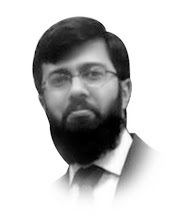The Matrix of Pakistani Politics
This piece shall not delve into the nature of the electoral system, although there is much to be said about how that might affect the system. Rather it shall focus on the contours of the political spectrum and shall posit the hypothesis that the traditional left-to-right spectrum that seems to work well in most other countries does not quite work in Pakistan. This hypothesis best works under the conditions where one ignores the blatant self-serving manoeuvres, which admittedly is a daunting task. While it seems unreasonable to ignore such a prominent feature of Pakistani politics, it is necessary to seperate the actions of the politicians from the political ideologies that they supposedly represent. Failure to do so results in utter confusion because the only ideology that seems to motivate most politicians is naked self-interest.
And yet there are underlying ideologies that seem to rear their head every now and then. For instance, the refusal of the PPP to fully align themselves with MMA against Musharraf for fear of soiling their "liberal" credentials. Indeed, an alliance between Musharraf and the PPP -something that observers predict is in the offing - would be an ideological one in addition to having pragmatic utility.
Having laid out the argument, it is now time to present the evidence. But first, it would be prudent to define some terms. Hence, left-wing is taken to mean those who are opposed to the status quo, whereas the right-wing is taken to mean those seek to preserve important elements of the status quo. Liberal is taken to mean a person or entity who values liberty as the primary political value. A conservative is somebody who seeks to preserve traditional values. The two terms get confusing because modern conservatives tend to favour economic liberty much more so than modern liberals. Yet for the purposes of political analysis, we shall leave this aside for now and take it up more extensively in a discussion of economic policy (or lack thereof).
The definitions being laid out, one can turn to the actual parties and try and place them in spectrum. The argument is that there are two spectrums, the liberal-conservative spectrum as well as the the left-right spectrum. In most countries, these are perfectly collinear. However, in Pakistan's case, they seem to be almost perfectly perpendicular. (Forgive my use of mathematical terminology, but the study of political economy has taken a decidedly quantitative turn and hence such usage is unavoidable.)
The reason as to why I say that is the following:
PPP: It is liberal in the sense that it believes in allowing more social liberties to citizens but is right wing owing to the fact that it does not oppose - and indeed works with - members of the landed aristocracy and thereby contributes to the perpetuation of one of the key pillars of the status quo.
PML (all factions): It is conservative in the sense that it seeks to preserve traditional values and tends to stick to the old stances on issues such as women's rights and Kashmir, and it is right-wing in the sense that it does not seem to oppose the landed aristocracy and, with the exception of the Nawaz faction, the army either.
MMA (and all other religious parties): They are conservative in the sense that they believe in traditional values that they claim to derive from Islam but they are left-wing in the sense that they have shown themselves opposed to nearly everything about the existing system of governance. Though have worked pragmatically with most governments on issues that are important to them, they cling on to the ideal of changing the system to one that derrives its inspiration much more closely from the Quran and Sunnat. There are, of course, variations between the various Islamic parties but those shall be discussed in a later article.
MQM & ANP: They are probably the closest that Pakistan has to a left-wing party and, in the case of the MQM, also probably the one most closely modelled after the Bolshevik party from the days of the October Revolution of 1917 in Russia.They are liberal in its social values and are also left-wing in the sense that they favour greater political autonomy for the provinces, wish to change the structure of the federation, and have actively challenged the authority of the landed aristocracy in Sindh (MQM) and the NWFP (ANP).
From the above analysis, it is possible to conclude that there are at least four distinct quadrants of the Pakistani political system:
- Left-wing liberal
- Left-wing conservative
- Right-wing liberal
- Right-wing conservative
There are of course, several parties that fall in between. For instance, the regional parties such as the BNP, PMAP, JWP, etc are leftist when it comes to provincial autonomy but deeply conservative when it comes to most other things, particularly social issues.
If the above structure is true, then it seems that Pakistan's first-past-the-post system, which favours the existence of a two-party system, would probably be inadequate when it comes to political representation. An extended analysis of alternatives may be pursued at a later stage.

